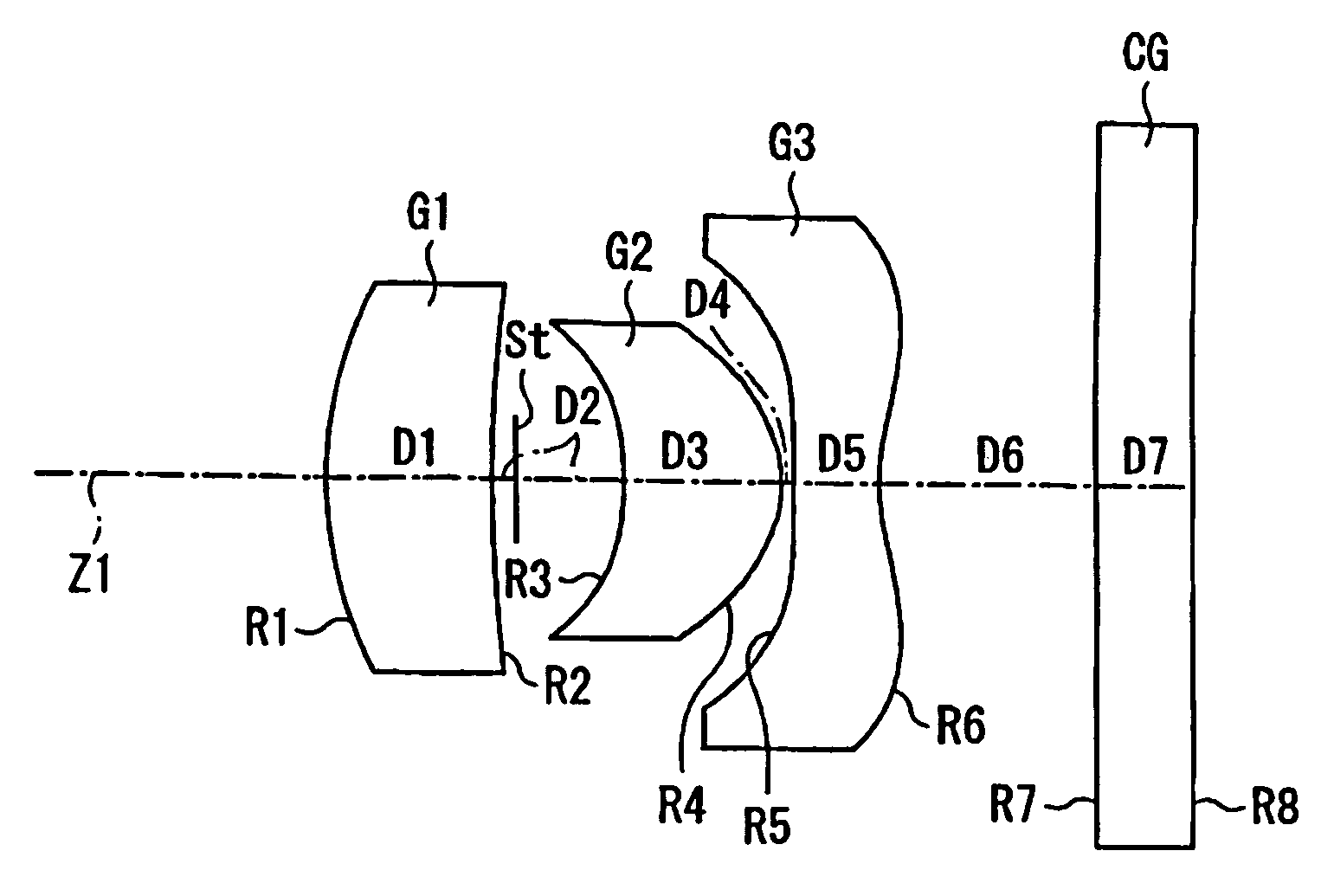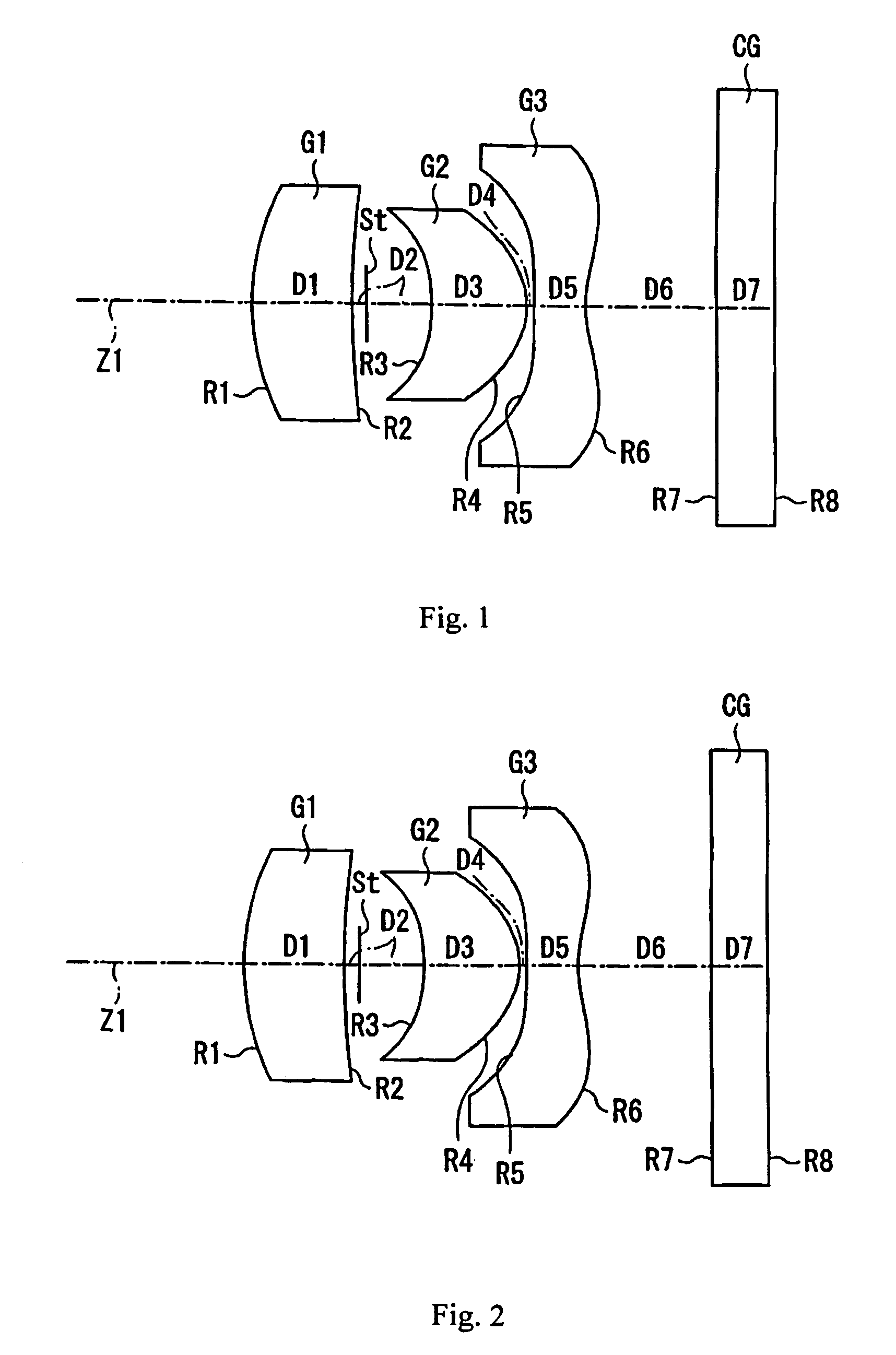Single focus wide-angle lens
a single-focus, wide-angle technology, applied in the field of single-focus wide-angle lenses, can solve the problems of unsatisfactory comprehensive performance of these lenses, small and lightweight size of image pickup devices using such image pickup elements, and disadvantages in productivity and cost, so as to achieve high performance and compactness, effectively using aspheric surfaces
- Summary
- Abstract
- Description
- Claims
- Application Information
AI Technical Summary
Benefits of technology
Problems solved by technology
Method used
Image
Examples
embodiment 1
[0042]Table 1 below lists the surface number #, in order from the object side, the radius of curvature R (in mm) of each surface on the optical axis, the on-axis surface spacing D (in mm), as well as the refractive index Nd and the Abbe number νd (both at the d-line of 587.6 nm) of each optical element, including the cover glass CG but excluding the stop St, for Embodiment 1. Listed in the bottom portion of Table 1 are the paraxial focal length f, the f-number FNO, and the maximum field angle 2ω at the d-line of 587.6 nm.
[0043]
TABLE 1#RDNdνd1 3.33941.401.6583057.32 13.51661.103*−2.33081.301.5086956.04*−1.02300.105*27.35630.701.5086956.06*1.51471.827 ∞0.801.5168064.28 ∞f = 5.15 mm FNO = 4.0 2ω = 65.0°
[0044]The surfaces with a * to the right of the surface number in Table 1 are aspheric lens surfaces, and the aspheric surface shapes are expressed by Equation (A) above.
[0045]Table 2 below lists the values of the constant K and the aspheric coefficients A3–A10 used in Equation (A) above...
embodiment 2
[0051]FIG. 2 shows Embodiment 2 of the present invention. Embodiment 2 is similar to Embodiment 1 and therefore only the differences between Embodiment 2 and Embodiment 1 will be explained. In this Embodiment, instead of the object side lens surface of the third lens element G3 being convex on the optical axis, it is concave on the optical axis.
[0052]Table 4 below lists the surface number #, in order from the object side, the radius of curvature R (in mm) of each surface on the optical axis, the on-axis surface spacing D (in mm), as well as the refractive index Nd and the Abbe number νd (both at the d-line of 587.6 nm) of each optical element, including the cover glass CG but excluding the stop St, for Embodiment 2. Listed in the bottom portion of Table 4 are the paraxial focal length f, the f-number FNO, and the maximum field angle 2ω at the d-line of 587.6 nm.
[0053]
TABLE 4#RDNdνd1 3.57401.401.7130053.92 13.00401.103*−2.47251.301.5086956.04*−1.02020.105*−51.78860.701.5086956.06*1.6...
PUM
| Property | Measurement | Unit |
|---|---|---|
| focal length | aaaaa | aaaaa |
| wavelengths | aaaaa | aaaaa |
| wavelengths | aaaaa | aaaaa |
Abstract
Description
Claims
Application Information
 Login to View More
Login to View More - R&D
- Intellectual Property
- Life Sciences
- Materials
- Tech Scout
- Unparalleled Data Quality
- Higher Quality Content
- 60% Fewer Hallucinations
Browse by: Latest US Patents, China's latest patents, Technical Efficacy Thesaurus, Application Domain, Technology Topic, Popular Technical Reports.
© 2025 PatSnap. All rights reserved.Legal|Privacy policy|Modern Slavery Act Transparency Statement|Sitemap|About US| Contact US: help@patsnap.com



